A letter of intent (LOI) agreement is a document that outlines the terms and conditions of a proposed transaction or agreement between two or more parties. It is a preliminary agreement that serves as a basis for negotiating and drafting a more detailed and comprehensive contract.
The letter of intent agreement typically includes the following information:
Parties involved: The names and contact information of all parties involved in the transaction.
Purpose: The purpose of the agreement, including the proposed transaction or deal.
Terms: The basic terms and conditions of the proposed transaction, such as the purchase price, payment terms, delivery terms, and any other relevant details.
Confidentiality: The agreement may include a clause that specifies that the terms of the letter of intent are confidential and that the parties will not disclose them to any third parties.
Exclusivity: The agreement may include a clause that prohibits the parties from negotiating with other potential partners for a set period of time.
Governing law: The law that will govern the agreement and any disputes that may arise.
Signatures: The letter of intent should be signed by all parties involved to indicate their agreement to the terms.
It is important to note that a letter of intent is not a legally binding document. Instead, it serves as a roadmap for negotiations and a guide for drafting a more comprehensive contract. It is always recommended to consult with a legal professional before entering into any business agreement or transaction.
Letter Of Intent Agreement
[Date]
[Recipient’s Name]
[Recipient’s Address]
[City, State ZIP Code]
Dear [Recipient’s Name],
We are pleased to submit this letter of intent agreement ("LOI") between [Your Company Name] ("Seller") and [Recipient’s Company Name] ("Buyer") in connection with the proposed purchase of [Product/Service] ("Product") as follows:
Parties Involved: The parties to this agreement are Seller and Buyer.
Purpose: The purpose of this LOI is to set forth the basic terms and conditions under which the Seller agrees to sell and the Buyer agrees to purchase the Product.
Terms: The terms and conditions of this proposed transaction are as follows:
Product: [Describe the Product in detail]
Purchase Price: [Specify the purchase price]
Payment Terms: [Specify payment terms]
Delivery Terms: [Specify delivery terms]
Term of Agreement: This agreement will be valid for a period of [Specify the duration of the agreement].
Termination: This agreement may be terminated by either party upon [Specify the termination conditions].
Confidentiality: The parties agree that the terms and conditions of this LOI will be kept confidential and will not be disclosed to any third parties without the other party’s prior written consent.
Exclusivity: For a period of [Specify the duration of exclusivity], Seller agrees not to negotiate with any other potential buyers or solicit any competing offers for the Product.
Governing Law: This LOI and any dispute arising out of it will be governed by and construed in accordance with the laws of [Specify the governing law].
Signatures: This LOI will be effective upon the signatures of both parties below.
[Your Company Name]
Professional Letter of Intent Agreement
Dear [Recipient Name],
This letter serves as our formal Letter of Intent regarding the proposed [Project/Partnership/Agreement] between [Your Company Name] and [Recipient Company Name]. We intend to outline the key terms, objectives, and commitments as a preliminary understanding pending a detailed agreement.
Our organization is committed to collaborating in good faith to achieve mutually beneficial outcomes. This LOI reflects our intention to move forward and engage in further negotiations to finalize a comprehensive agreement.
Sincerely,
[Your Name]
[Title]
[Your Company Name]
Casual Letter of Intent Message
Hi [Recipient Name],
I am writing to express our intent to move forward with the proposed collaboration on [Project/Initiative]. This message serves as a preliminary understanding of our mutual interest and willingness to negotiate terms in detail.
Looking forward to discussing the specifics and formalizing our agreement.
Best,
[Your Name]
[Title]
[Your Company Name]
Creative Letter of Intent Agreement
Dear [Recipient Name],
We are excited to express our intent to collaborate on [Project/Program Name]. This letter outlines our initial understanding and vision for a partnership that leverages innovation, creativity, and shared goals.
We are eager to work together to develop a full agreement that captures the spirit of this collaboration.
Warm regards,
[Your Name]
[Title]
[Your Company Name]
Formal Letter of Intent for Business Agreement
Dear [Recipient Name],
This Letter of Intent confirms our interest in entering into a formal agreement with [Recipient Company Name] regarding [Specific Project/Transaction]. The purpose of this LOI is to outline preliminary terms, responsibilities, and commitments prior to executing a definitive agreement.
We emphasize that this letter is non-binding except where explicitly stated and serves as a framework for further negotiations.
Sincerely,
[Your Name]
[Title]
[Your Company Name]
Provisional Letter of Intent
Dear [Recipient Name],
This letter is issued as a provisional Letter of Intent to confirm our interest in exploring a potential [Partnership/Acquisition/Project] with [Recipient Company Name]. Details are subject to further discussions and adjustments.
We look forward to negotiating the full agreement and finalizing terms that are mutually acceptable.
Regards,
[Your Name]
[Title]
[Your Company Name]
Quick Letter of Intent Email
Hi [Recipient Name],
This is to express our intent to engage in discussions regarding [Project/Initiative]. We look forward to defining terms and moving toward a formal agreement.
Thanks,
[Your Name]
[Title]
[Your Company Name]
Heartfelt Letter of Intent
Dear [Recipient Name],
It is with great enthusiasm that we submit this Letter of Intent expressing our desire to collaborate on [Project/Partnership]. We value the opportunity to work together and aim to develop a strong, mutually beneficial relationship.
We are committed to open communication and transparent negotiations as we move toward a formal agreement.
Warm regards,
[Your Name]
[Title]
[Your Company Name]
What is a Letter of Intent Agreement and Why You Need It
- A Letter of Intent (LOI) is a document expressing preliminary commitment toward a project, partnership, or agreement.
- Its purpose is to outline key terms, intentions, and expectations before drafting a full contract.
- Provides clarity and ensures both parties understand the scope, goals, and responsibilities.
- Serves as a reference point for negotiations and formal agreement development.
Who Should Send a Letter of Intent Agreement
- Authorized representatives of the company or organization initiating the LOI.
- Executives, legal officers, project managers, or department heads depending on context.
- Only individuals empowered to negotiate or express preliminary agreements should send LOIs.
Whom Should a Letter of Intent Be Addressed To
- Key decision-makers at the recipient organization.
- Project stakeholders, business partners, or legal representatives.
- Salutations should be professional and tailored to the recipient, e.g., “Dear [Title/Name]” or “To Whom It May Concern” if unknown.
When Should You Use a Letter of Intent Agreement
- Prior to formalizing partnerships, mergers, acquisitions, or business collaborations.
- When initiating negotiations for a joint venture or contractual agreement.
- To establish understanding of responsibilities and objectives before drafting binding contracts.
- In preliminary discussions to signal commitment and seriousness.
How to Write and Send a Letter of Intent Agreement
- Begin with a clear subject line and greeting.
- State the purpose and intent of the letter.
- Outline preliminary terms, objectives, or conditions.
- Clarify what is binding versus non-binding.
- Conclude with a commitment to negotiate a formal agreement.
- Send via email or printed letter on company letterhead, depending on formality.
How Many Letters of Intent Are Typically Needed
- Usually one LOI per project, transaction, or collaboration.
- Separate letters may be required for multi-party agreements.
- For large organizations, copies may need to be shared with legal and executive teams for record-keeping.
Requirements and Prerequisites Before Drafting an LOI
- Clear understanding of the project, partnership, or transaction scope.
- Agreement on preliminary terms and objectives among internal stakeholders.
- Authorization from company leadership to issue the LOI.
- Awareness of legal considerations and binding clauses.
- Recipient information, including contacts and decision-makers.
Formatting Guidelines for a Letter of Intent Agreement
- Length: 1–2 pages; concise and structured.
- Tone: professional, formal, or occasionally creative depending on context.
- Style: introduction, preliminary terms, intentions, and closing.
- Include signature, title, date, and company information.
- Mode: printed on letterhead for official LOIs, or email for digital submissions.
- Clearly state binding and non-binding sections to avoid legal confusion.
Common Mistakes to Avoid in a Letter of Intent Agreement
- Including overly detailed terms better suited for the final agreement.
- Failing to specify binding versus non-binding elements.
- Sending without proper authorization or approval.
- Using ambiguous language or vague commitments.
- Neglecting proper formatting or professional tone.
Elements and Structure of a Letter of Intent Agreement
- Salutation and recipient address
- Purpose and intent statement
- Preliminary terms and scope of project/partnership
- Binding vs. non-binding clauses
- Commitment to negotiate final agreement
- Closing and signature
- Date, title, and company information
- Optional attachments or reference documents
Tips and Tricks for Writing a Strong LOI
- Keep the letter concise but comprehensive.
- Clearly differentiate between binding and non-binding statements.
- Tailor language to reflect seriousness and professionalism.
- Use official letterhead or approved email channels.
- Review internally for clarity and legal compliance before sending.
- Maintain records for reference during negotiations.
Pros and Cons of Using a Letter of Intent Agreement
- Pros:
- Establishes preliminary understanding and commitment.
- Provides a reference for negotiation and final agreement drafting.
- Builds trust and formalizes intent without full legal obligation.
- Cons:
- Misunderstanding of binding vs. non-binding statements can cause legal issues.
- Overly vague letters may be ignored or rejected.
- Can create premature expectations if not carefully worded.
After Sending or Following Up on a Letter of Intent Agreement
- Confirm receipt with the recipient.
- Be prepared to provide clarification or additional information.
- Track responses and schedule meetings for detailed negotiations.
- Keep copies for internal record-keeping and legal reference.
Does a Letter of Intent Require Attestation or Authorization?
- Typically requires signature and title from an authorized company representative.
- Some industries or agreements may require notarization or additional legal attestation.
- Always verify with legal counsel or company policy before sending.

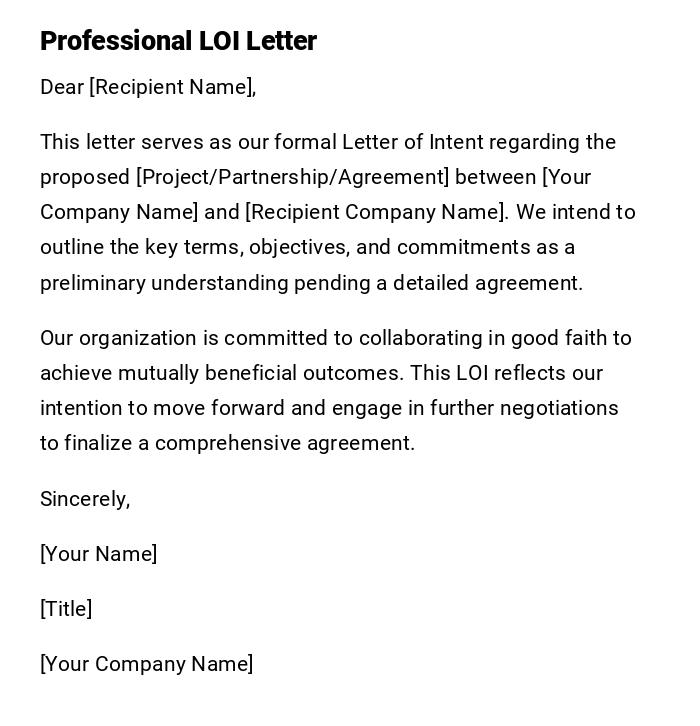
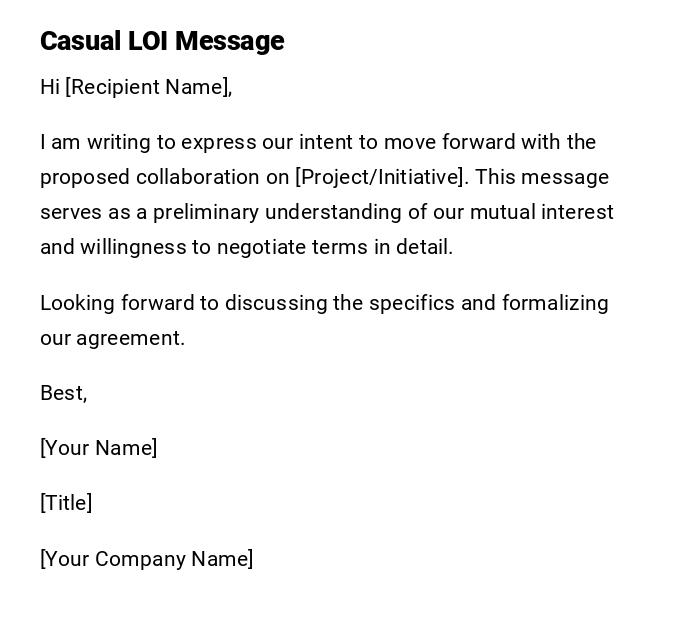

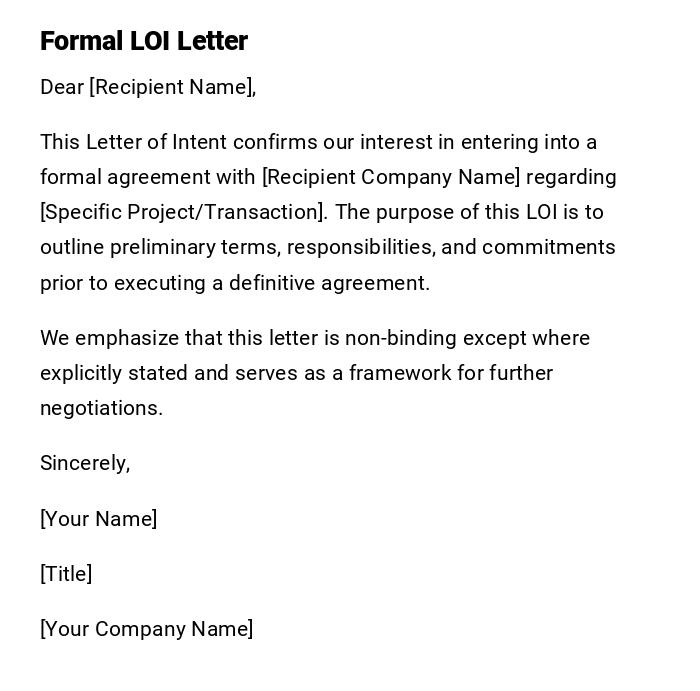
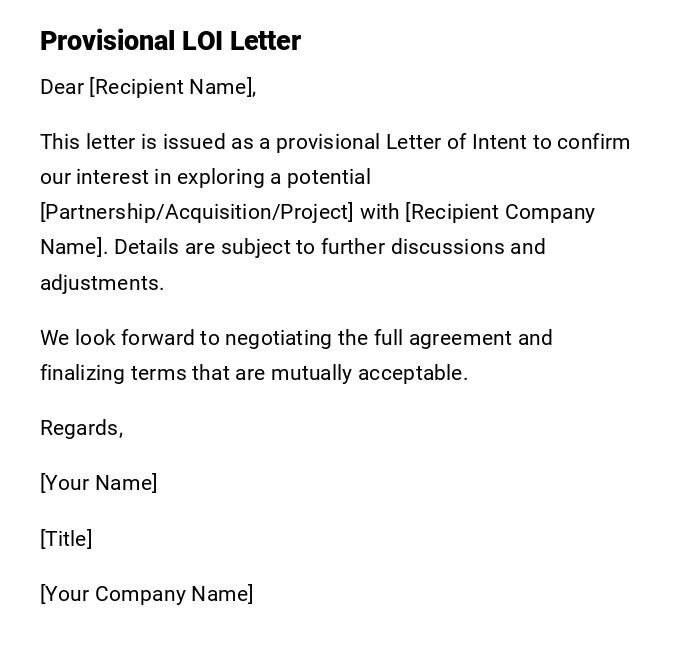
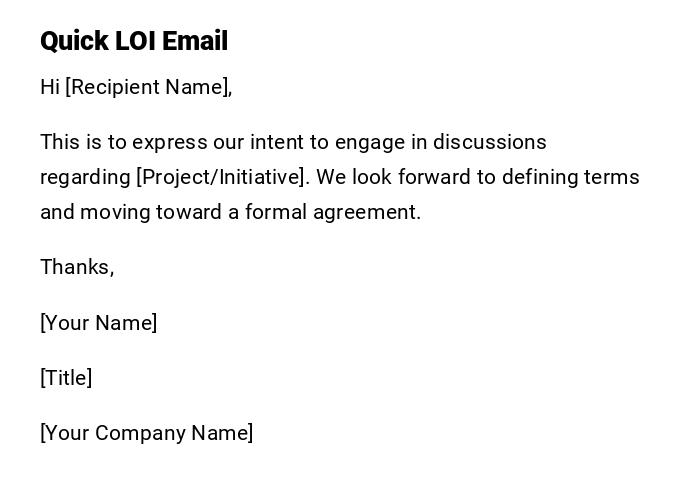
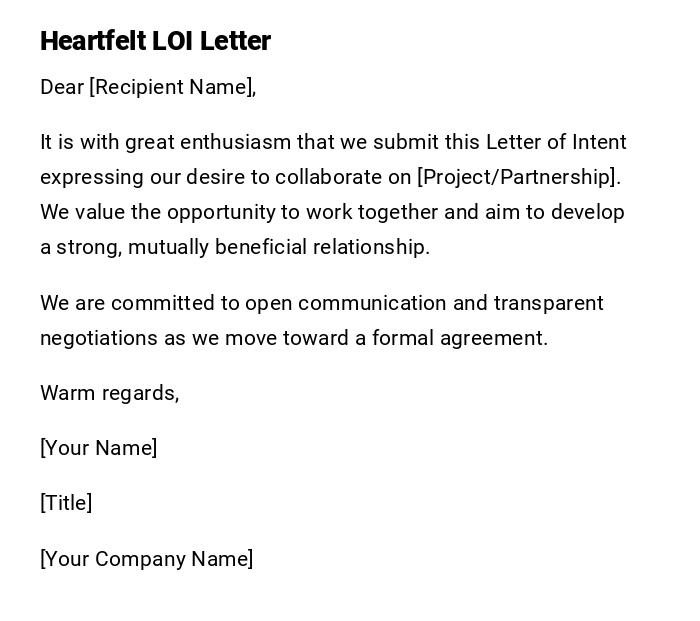

 Download Word Doc
Download Word Doc
 Download PDF
Download PDF